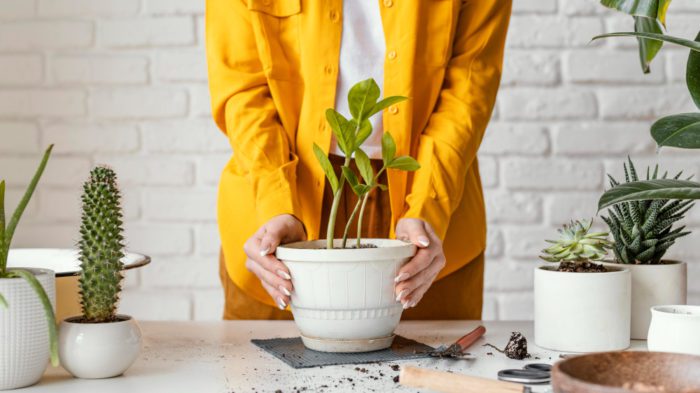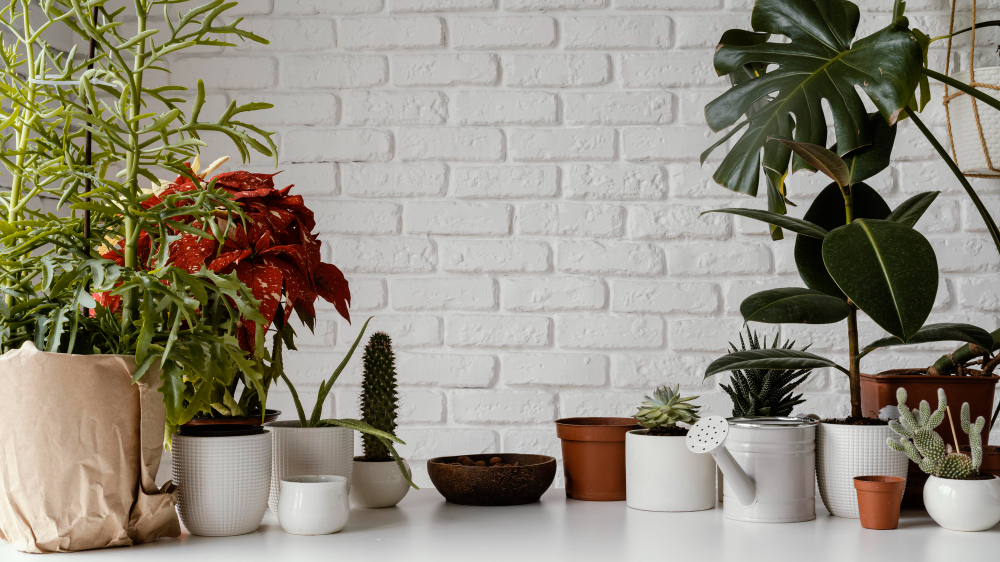You sit next to your favorite indoor plant, start sipping a cup of coffee and enjoy some peace. But suddenly, a few insects start buzzing around you. Well, you are not even outdoors to witness this happening to you and quickly get annoyed.
However, you realize that these tiny flying insects are none other than gnats, and they dwell on your indoor plants. (Technically, the gnat species found near indoor plants are called fungus gnats)
Now you get these questions in your mind: Are gnats bad for plants? Whether they are bad for plants or not, these creatures create a nuisance. So how to get rid of them? What are the preventive measures?
No worries, you will find all the answers in this article. So without any delay, quickly go through this article and solve your gnats problem.
What Are Fungus Gnats?

Fungus gnats are species of gnats family that are often found dwelling in your indoor plant pots, especially where humidity and moisture levels are high.
These creatures measure 1/8 inch with slender and segmented bodies, long legs and dark wings, and one antenna. Further, you can also spot a Y-shaped pattern on their wings.
Though these tiny creatures are often mistaken for a mosquito or fruit fly, they are completely different. Unlike other flying bugs, they aren’t strong fliers.
Also, fungus gnats have the same characteristics as other gnat species, apart from their appearance and habitat.
The female fungus gnats also reproduce rapidly by laying upto 200 to 500 eggs within their short lifespan.
After 3 days, the eggs hatch, and the larvae, also called maggots, come out and bury themselves into the soil. The maggots have blackheads and an elongated translucent body.
And within a week or two, the maggots turn into adult fungus gnats and start flying around the indoor plants and inside your house in search of food.
As already said, there are multiple species of gnats, where some bite humans and pets and suck blood. However, fungus gnats are harmless to humans, and they neither bite humans nor spread any disease.
The only thing which suffers due to fungus gnats is plants. This is because fungus gnats feed on indoor plants.
Now that you learned that fungus gnats feed on plants, did you get this doubt on what kind of plants gnats look for?
Well, any plant is a target for fungus gnats; however, these creatures have a soft corner for orchids, African violets, geraniums, carnations, cyclamens, and poinsettias.
Now comes the next question, how to detect the gnats infestation in your plants. So that’s what we will discuss in the next section. Continue reading.
Signs Of Fungus Gnats
Fungus gnats mainly survive on indoor plants. The larvae which bury themselves into the soil will feed on the algae, decaying matter like dead leaves and the roots of the plant.
But with this information, how can you detect the fungus gnat infestation in your plants?
Well, you check out for the below-given symptoms in your plant.
Even after regularly watering your plant and looking after them, if they show symptoms like sudden wilting, poor growth, loss of vigor, and yellowing of leaves, then you can confirm that it’s the fungus gnat infestation.
Let’s elaborate on fungus gnat damage.
In general, gnats are annoying creatures, and we avoid them as they cause nuisance when in a big swarm.
Though adult fungus gnats don’t cause any harm to humans, when their population exceeds a certain number, their larvae may start feeding on the plant roots and cause severe damage, especially if it’s a young plant with few delicate roots.
Fungus gnats also spread plant pathogen in plants and cause damping-off, which results in the seedlings’ death.
Also, your plants might encounter other root-related issues like root rot which also results in killing the plant. So if you find any gnats around plants, then you can assume that something is fishy.
What Causes Gnats in Plants?

Now that you have learned about the signs of fungus gnats infestation in your plant, did you get this thought about what causes fungus gnat infestation, especially in plants?
Gnats or fungus gnats dwell in places where abundant food, moisture, and warm temperature exists. So plants remain a great source of food and shelter for fungus gnats. They survive on the organic matter and fungus present in the soil. Only in the worst case (large infestation) they start to eat the roots and tiny leaves of plants.
The adults lay their eggs in the soil, the larvae that hatch then bury inside the top layer of the soil and feed on the organic material in the soil and plant’s root hairs.
Usually, these larvae go unnoticed unless you give a close look at the soil. In most cases, it’s the larvae that do the most damage to plants.
Since they aren’t visible to the naked eye, you might miss out on them. Only when the plant stunts growth you start to wonder what is wrong with it.
Also, within 10 days, the larvae develop into pupae, and after 3 days, the adult gnats start popping out. So a new generation of fungus gnats comes out in less than three weeks.
So if you detect the fungus infestation in its early stages, you can save your plant from dying.
How To Get Rid of Gnats in Houseplants?
There are multiple ways to keep gnats away. In this section, let’s learn about them.
First, we will suggest ways to kill fungus gnats naturally.
Cider-vinegar trap
Take a small container or bowl and fill it with equal parts of apple cider vinegar and water. Then add a few drops of liquid dish soap into the mixture and stir it well.
Now place this mixture near the plant pot’s base or, if needed, on the top of the soil(if there’s space). Leave this mixture undisturbed for a few days. After two or three days, you will notice fungus gnats floating dead in the mixture.
Are you wondering how this trick worked? Well, gnats get attracted to the vinegar and sit down on the mixture; the dish soap traps them and eventually kills the gnats.
Note: For every three days, add a few drops of vinegar and water to make it effective against gnats.
The fungus gnat larvae are the main cause of plants death as they cause root rotting, so it is important to eliminate them first. In this section, we have covered some home remedies and quick ways to keep gnats away.
Hydrogen Peroxide
Hydrogen peroxide is a common household item that can be easily used in controlling pests, especially fungus gnats. This chemical helps in healthy root growth because of its extra oxygen molecule presence.
So the extra oxygen enables roots to absorb more nutrients and thus makes them grow vigorously. However, it works perfectly against gnats.
To make this mixture, mix one part of hydrogen peroxide with four parts of water and pour it into the soil near the root zone until the mixture starts to come out of the base of the pot. The peroxide kills the fungus gnat larvae on contact.
Neem oil
Neem oil also works against fungus gnats and repels them. You can dilute the neem oil with water as per the manufacturer’s direction and drench the soil at the roots of the plant. Also, spray the plant’s upper portion to keep the adult fungus gnats away.
Mosquito dunks
Another simple non-toxic way to get rid of fungus gnats larvae is to use Bacillus Thuringiensis(Bti), a naturally-occurring bacterium found in soil.
Mosquito dunks are dry pellets that consist of a bacteria named Bacillus thuringiensis, a subspecies of israelensis which kills the larvae. This bacteria contains spores that produce toxins and affect the larvae of insects like mosquitoes, fungus gnats, and blackflies.
Mix the bacterium dry pellets in water and dissolve them. Use this mixture on the plants. It is recommended to soil drench it with this Bti mixed water so that it penetrates deep into the soil and kills the fungus gnats larvae.
You can also break it into pieces or let it partially dissolve and remove it for later use.
Note: Follow the instructions given in the product you purchase to get the best results.
It is recommended to use the pellets for two or three months if you want to completely clear the gnat infestation.
Potato slices
This might sound silly, but it works great. Gnats larvae love raw potatoes. So cut small slices of raw potato, bury them in the potted plants and leave them for at least 4 or 8 hours.
After a few hours, pull out the potato chunks, and you will notice the small chunk crawling with larvae. Now dispose of the chunk to get rid of larvae cling-on.
Chamomile tea and cinnamon
These two are natural fungicides, and thus they can kill the gnat’s primary food source, i.e., fungus. and makes the soil unfit dwelling area for gnats.
To prepare this gnat spray for the plant, brew a liter of strong chamomile tea in boiling water. Allow the tea to cool and mix it with 4 parts of water. Then use the tea mix to water plants as usual. Then sprinkle the cinnamon on the surface of the potted plant’s soil. This combo will reduce the gnat infestation to a great extent.
Repeat this method for 3 weeks for effective results.
Bacillus Thuringiensis(Bti)
Treat the soil with Diatomaceous earth
Diatomaceous earth is a powder made from sediment of fossilized algae and is safe to use on all plant types in your home and garden, but it kills fungus gnats.
How does this work against gnats? This powder absorbs moisture from the plants and effectively dehydrates the creatures. It gets into the joints and causes internal injuries to the gnats.
So dust the affected plant soil’s surface with diatomaceous earth.
This is highly recommended if you are working to clear the fungus gnat infestation in outdoor plants.
Note: If you have dusted the diatomaceous mixture on the pot, avoid too much water in plants as this mixture gets washed away. So water plants from the bottom or else add more powder once you water the plants.
Sticky traps
If you are looking for the fastest way to get rid of gnats, then use sticky traps. These sticky cards consist of a yellow notecard covered with sticky adhesive. Gnats get attracted to bright colors. So this gnat killer would come and sit on the trap and get stuck with it and die
They come in square shapes and can be placed directly on the soil.
Paste this trap near the plants or use a toothpick or small stick to support it and place them in the soil. Sticky traps effectively control the adult fungus gnat population.
Flypaper
The flypaper ribbons are another effective ways to trap fungus gnats. This trap is often used in horse barns or cattle sheds to catch outdoor flies but can also use to catch fungus gnats. However, when used indoors, make sure the ribbons don’t stick the things like plants furniture kept around.
How To Prevent Fungus Gnats?

By following the above-given methods, you can easily get rid of the fungus gnat infestation in your plants. However, don’t you doubt whether there would be future infestation?
If you did, you were right. You can get rid of gnats but can’t guarantee that their infestation won’t pop up again. So to prevent fungus gnats infestation, there are some preventive measures to be taken. Some of them are
Keep the soil dry
Fungus gnats love moisture and exist around it. If you have encountered a fungus gnat infestation in your plants, then allow the soil’s houseplant to dry out a bit between waterings.
This process can slow down or completely get rid of fungus gnats due to the absence of moisture. Also, gnats will stop laying eggs in dry soil. So you can avoid tottling root problems caused by the larvae as well.
Cover the drainage holes
The drainage holes here refer to the houseplant pots drainage part. Though adult gnats are found flying around plants and laying eggs on the soil’s surface, they may find a way to enter the drainage hole of the pot and start breeding there.
So it covers the holes with synthetic fiber and prevents gnats from getting inside. However, don’t block the part completely. Otherwise, the water would be stagnant.
Cover the exposed soil with sand
If you want to water plants but also stop the fungus infestation, then here is a trick. Try to cover the topsoil or exposed soil with at least 3/5 inches of sand to prevent the fungus gnats from accessing the soil and laying eggs.
Note: This trick works better when you cover the pot’s drainage hole and then add sand to the topsoil so that you won’t give a chance for the gnats to exist.
Inspect the plants for fungus gnats
If you purchase potted plants, thoroughly inspect the plant pot for any fungus gnat infestation. In case you see any gnats flying around the potted plants, reject it straight away. Also, you can insert your finger and check for any larvae.
Use Insect repellents spray regularly on plants
You can spray biological and synthetic insecticides for quick results against fungus gnats. However, they are not a long-term solution. While spraying these insecticides, cover your face and hands completely, and don’t let kids or pets-animals near the pot.
Separate the infected plant.
While inspecting your indoor plants, if you find any plant infested with fungus gnats, then it is recommended to separate it from others. By doing so, you will stop the infestation spread in your plants.
Remove the topsoil
Another way to get rid of gnats in houseplants is to reduce debris in the soil. The decaying organic matter like leaves flowers becomes a haven for gnats, and they prefer to lay their eggs. So it is vital to clean the debris often and avoid the gnats problem.
Also, if you find the topsoil covered with gnat larvae, consider removing the layer of soil and throwing it away.
Conclusion
You don’t have to wait for your plants to show fungus gnats’ symptoms. You can do a regular check for a fungus gnat infestation. The early you detect, the more you can save your plants from dying.
So that’s the end of the article. We hope you got a clear understanding of what fungus gnats are and how much they can cause trouble to your beautiful indoor plants. We have given a clear idea about their signs of infestation and how to handle their infestation. Thanks for patiently reading this complete article. Cheers!
